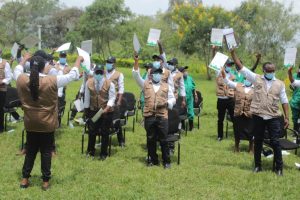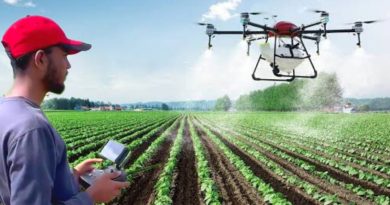Farmer-to-Farmer awareness Campaign Reduces Burden of RVF in Rwamagana
Though Rwamagana was among the districts in Rwanda’s eastern province affected by the Rift Valley Fever (RVF) outbreak, farmer-to-farmer awareness campaigns reduced losses and helped them cope.


Through the Livestock Farmers Field School (LFFS) the local government trained the most influential livestock farmers for them to also train and mobilize others.
RVF is a viral disease that mostly affects domesticated animals such as cattle, buffalo, sheep, goats, and camels. People can get RVF through contact with blood, body fluids, tissues of infected animals and bites from infected mosquitoes.
Although RVF often causes severe illness in animals, most people with RVF have either no symptoms or a mild illness with fever, weakness, back pain and dizziness. However, a small percentage (8-10%) of people with RVF develop much more severe symptoms including eye disease, hemorrhage (excessive bleeding), and encephalitis (swelling of the brain).
With Rwamagana neighboring Kigali, Rwanda’s capital city, most of the local people are engaged in commercial activities rather than agriculture and livestock breeding. Besides, unlike other areas of the Eastern province, those that practice farming and breeding are small-scale.
During the RVF outbreak, local authorities urged farmers to prevent and control the disease by vaccinating their animals, feeding them well including a balanced diet, the right feed and in the right amounts plus adequate water at all times so that the animal can take as much as it needs in order to build immunity, and spraying them regularly with appropriate chemicals which are insecticide, the most used is Permapy plus .
Through the Livestock Farmers Field School (LFFS) – a countrywide program that began in 2017- the local government trained the most influential livestock farmers for them to also train and mobilize others. The program is based on cell level basic administrative unit composed of several villages. One advisor is in charge of a certain number of fellows, which varies from one cell to another.
Every cell has at least an advisor selected by other livestock farmers, who is trained and whose role is to advise and work closely with others.
The advisor is nominated by other livestock farmers during a local community meeting in their villages. They are selected based on influence, skills, knowledge, dedication and willingness to help peers; a livestock advisor trains them on how to take care of their animals. Training is provided by the government free of charge by professionals from the Ministry of Agriculture and animal resources.


The livestock advisors are trained for five years and the training is carried out in stages based on the topic, some will last for two months while some will last for two weeks. They are trained on how to treat and prevent diseases, feeding the animals appropriately to help raise their immunity.
Jean Paul Habumuremyi, a beneficiary of LFFS from Kigarama cell, Nzige sector, says that after training they are expected to go down to their villages to help their fellows with the skills they get from training.
According to Habumuremyi they form groups of livestock farmers in the villages where they work. They teach the farmers what they have learned, and raise awareness about government programs in livestock sector such as immunization of animals to deal with various diseases and putting them on insurance. The teachings are delivered during cells’ weekly gatherings and some other occasional times based on the current messages.
The whole Rwamagana district has 67 trained livestock advisors who operate in 82 cells with 17,920 livestock farmers. They are not on paycheck; they just work as volunteers and get some little motivation once in a while such as bicycles and allowance when they attend training; though not regularly.
In addition to being mentors to their colleagues, the trainees make use of the knowledge they have gained from the training, for example, Habumuremyi now grows and multiplies reeds for livestock professionally, earning his own income and doing it as a job and business.
The RVF intensity eased
Elie Ugiraneza is a livestock farmer but also an advisor in this program from Karenge sector in Rwamagana district, he coordinates around 25 fellow livestock farmers. He had two cows both got RVF but were treated on time and recovered. He was well prepared.
“When the disease attacked my cows, I knew that I shouldn’t touch their blood so that I don’t get myself infected, and that I had to call in the veterinary as soon as I see RVF symptoms,” said Ugiraneza.
He says that he was aware of some RVF symptoms like fever, nose bleeding and lack of energy among others. Therefore, he quickly contacted the veterinary to treat the cows and both survived the RVF.
Some of the advice given to livestock farmers in order to prevent and ease the intensity of RVF is to feed their livestock well with a nutritious diet to boost their immunity, spraying insecticide at least twice a week and getting their livestock vaccinated.
In addition, if they see signs of the disease, avoid contact with the blood of a sick animal and call a veterinarian instead.
Ugiraneza confirms that in his group, those who followed the advice did not lose their cattle.
With livestock farmers being aware of the effects of RVF, they did everything possible to prevent the disease including cutting down bushes to remove mosquito hideouts and draining water bodies so they cannot breed.
Goreth Murekerisoni, a livestock farmer in Nsinda cell, Muhazi sector says that since they knew how to prevent RVF. Among her nine cows, one was infected but was treated on time and cured thanks to the advice she got from their advisors.
“I used to hear on radio about the RVF, and our local leaders used to remind us to be on guard, so I cut all bushes around my home, and I was always vigilant in case one of my cows would show the RVF symptoms,” said Murekerisoni.
She says that she feeds her cattle with the reeds and gives them enough water; their barn is also clean enough and they are sprayed severally a week.
According to Rwanda agriculture and Animal resource development Board, Rwamagana had 60 RVF cases 26 were treated and 34 died in 2022; many livestock farmers were not affected.
According to Rwamagana district animal resources officer, Dr. Jean De Dieu Niyitanga, since April to July 2022, 285, 005 cows were vaccinated. So far, there is no more RVF in the region. Moreover, in just three months, the anti-RVF operations cost around 15 million Rwandan francs.
Wilson Sekabera from Muhazi sector lost his one and only cow to RVF. He did not have prior knowledge before the advisors taught him.
However, he says the advisors are the ones who taught them how to deal with epidemics like RVF, and how to feed their livestock properly.
Murekerisoni says that livestock advisors trained them on how to fight mosquitoes that are said to be spreading RVF, how to grow grass and how to feed cows properly; they also encouraged them to take livestock insurance.
Despite being able to handle the last RVF outbreak, livestock farmers in Rwamagana are still afraid that the next outbreak might not go easy on their cattle yet getting insurance is still a big challenge.
The insurance is 5.5 percent of the value of one cow and it is paid once per year, this is still expensive for the low-income livestock farmer, Murekerisoni says.
“Not all variety of cattle is allowed in insurance scheme, the priority was given only to dairy cows and productive pork and chicken; and when they are sick you will have to get them treated on your account, insurance will step in only if they are dead,” she said.
Ugiraneza notes that though he keeps mobilizing, it is not easy to convince his fellows to insure their livestock as the insurance costs are high for those with one or two cows.
In addition, areas near lakes and swamps such as Rwamagana, and near the rivers of Akagera and Akanyaru are breeding grounds for mosquitoes; hence, it is easy for animals to be infected with RVF.




